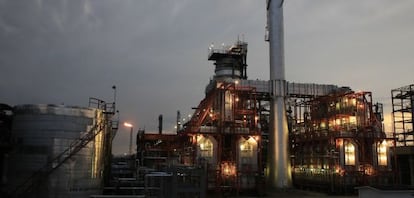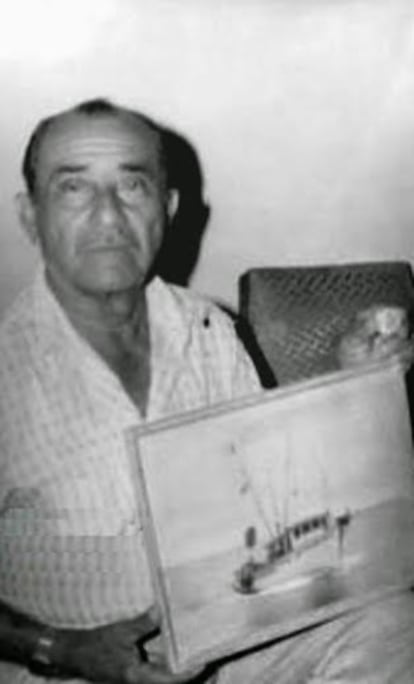The Mexican oil treasure found by a fisherman
In 1961 Rudesindo Cantarell saw a dark patch that led to the discovery of a huge reserve Now the site is being studied as an example of the poor management of state oil


It was July 1961 when Rudesindo Cantarell Jiménez saw something strange while he was fishing in the Bay of Campeche, in the south of the Gulf of Mexico.
From on board the Centenario del Carmen trawler he saw a black patch in the turquoise-colored waters of the Caribbean. Cantarell could not believe his eyes.
Nevertheless, he did not tell anyone about his discovery until 1968, when he made the acquaintance of an engineer from Mexican state oil firm Petróleos Mexicanos (Pemex).
It wasn’t until 1979 when the Mexican government began exploiting its biggest natural resource
Three years later, officials announced that the biggest global oil reserve in the Americas and the second-biggest in the world had been discovered 70 kilometers from what is now the popular Mexican resort of La Playa del Carmen.
But it wasn’t until 1979 when the Mexican government began exploiting its biggest natural resource. Now, though, that project is being help up as an example of the bad management of the country’s oil industry.
The oil boom put Mexico at the center of OPEC, the organization of petroleum-producing countries. Decades of Mexican governments under the control of the Institutional Revolutionary Party (PRI) used the oil find to obtain international financing to create a host of huge infrastructure projects. The small dark patch that Cantarell saw seemed to extend across Mexico, from one coast to the other.

But then in the early 1980s, global oil prices started to sink at the same time as interest rates shot up. The Mexican government’s inability to meet loan payments pushed it into a dismal crisis that lasted a decade.
As revenues from Pemex rose to make up 40 percent of Mexico’s budget, the reliance on oil money also numbed competitiveness.
Now, though output is falling – Pemex’s production has dropped from 3.3 million barrels a day to 2.5 million over the last 10 years – revealing the stagnation of the state monopolistic system.
Mexico’s entire energy history is a paradox: the country's 53 million poor live above around 30 billion barrels of oil and 500,000 million cubic feet of natural gas. But Mexican law has always prohibited private firms from prospecting.
Last year, President Enrique Peña Nieto, of the PRI party, finally opened the state-owned energy sector to some private investment – an opening that may help many Mexicans emerge from poverty.
But Cantarell won’t see that change. He died in 1997 at age 83. There is, however, one small reminder of his legacy – the offshore drilling site in the Bay of Campeche carries his name: Cantarell.
Tu suscripción se está usando en otro dispositivo
¿Quieres añadir otro usuario a tu suscripción?
Si continúas leyendo en este dispositivo, no se podrá leer en el otro.
FlechaTu suscripción se está usando en otro dispositivo y solo puedes acceder a EL PAÍS desde un dispositivo a la vez.
Si quieres compartir tu cuenta, cambia tu suscripción a la modalidad Premium, así podrás añadir otro usuario. Cada uno accederá con su propia cuenta de email, lo que os permitirá personalizar vuestra experiencia en EL PAÍS.
¿Tienes una suscripción de empresa? Accede aquí para contratar más cuentas.
En el caso de no saber quién está usando tu cuenta, te recomendamos cambiar tu contraseña aquí.
Si decides continuar compartiendo tu cuenta, este mensaje se mostrará en tu dispositivo y en el de la otra persona que está usando tu cuenta de forma indefinida, afectando a tu experiencia de lectura. Puedes consultar aquí los términos y condiciones de la suscripción digital.
Archived In
Últimas noticias
Most viewed
- Reinhard Genzel, Nobel laureate in physics: ‘One-minute videos will never give you the truth’
- Oona Chaplin: ‘I told James Cameron that I was living in a treehouse and starting a permaculture project with a friend’
- Pablo Escobar’s hippos: A serious environmental problem, 40 years on
- Charles Dubouloz, mountaineering star, retires at 36 with a farewell tour inspired by Walter Bonatti
- Why we lost the habit of sleeping in two segments and how that changed our sense of time








































